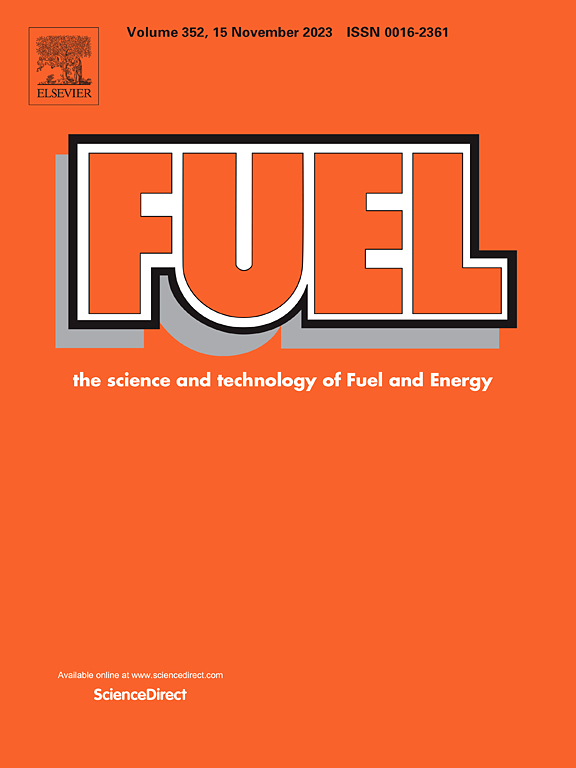含硼/催化剂纳米杂化颗粒纳米燃料燃烧行为的详细研究
IF 6.7
1区 工程技术
Q2 ENERGY & FUELS
引用次数: 0
摘要
硼具有很高的理论热值,是一种很有前途的替代燃料,但它的氧化行为问题阻碍了完全燃烧,限制了它的潜力。本文主要研究了用球磨法制备B2O3还原层非晶态硼(AB)颗粒,并用钙钛矿型纳米催化剂(La0.7 Nd0.3MnO3, Nd0)对其进行修饰。7Ba0.3MnO3, La0.5 Nd0.3Ba0.2MnO3)采用高性价比的超声方法。采用扫描电镜和x射线衍射(XRD)技术对颗粒进行了结构表征。为了评价纳米催化剂的催化活性,分别用XPS和BET分析进行了元素分析和表面积测量。对汽油基纳米燃料(2.5 wt%和7.5 wt%)在受控液滴尺度的燃烧室中的燃烧试验表明,较高的颗粒浓度减少了点火延迟。然而,硼杂化颗粒的点火延迟与纯硼颗粒相似。7.5 wt% AB-LNM1、AB-NBM和AB-LNBM1液滴的残余聚集体温度分别比AB-BM高115%、100%和110.4%。SEM-EDX分析表明,AB-LNBM1杂合物催化效率最高,碳含量为5.47%,氧含量为17.53%,显著改善了硼和烟灰的氧化。在使用250 ppm柴油混合物的发动机测试中,NBM纳米颗粒的BSFC最低,而AB-LNBM1在60 Nm时的HRR增幅最高(12.69%),二氧化碳排放量最高(9.53%)。AB-LNBM1在15 Nm时减少了53.33%的HC排放,而在30 Nm时,NBM的NOx减少量最大(9.70%)。总的来说,硼/催化剂纳米混合材料增强了燃烧性能,提高了燃油效率,减少了污染物排放。这些发现表明,这种混合燃料在推进替代燃料应用和减少碳氢化合物燃料对环境的影响方面具有巨大的潜力。本文章由计算机程序翻译,如有差异,请以英文原文为准。
A detailed study of the combustion-fuel behavior of nanofuels containing boron/catalyst nanohybrid particles
Boron, with its high theoretical calorific value, is a promising alternative fuel, but its problematic oxidation behavior prevents complete combustion and limits its potential. This study focuses on the production of amorphous boron (AB) particles with reduced B2O3 layers using ball milling and their decorating with perovskite-type nano catalysts (La0.7 Nd0.3MnO3, Nd0. 7Ba0.3MnO3, La0.5 Nd0.3Ba0.2MnO3) by a cost-effective ultrasonication methods. The structural characterizations of all particles were characterized by SEM and XRD techniques. To evaluate the catalytic activity of the nanocatalysts, elemental analysis and surface area measurements were carried out by XPS and BET analysis, respectively. Combustion tests on gasoline-based nanofuels (2.5 and 7.5 wt%) in a controlled droplet-scale chamber showed that higher particle concentrations reduced ignition delay. However, boron hybrid particles had ignition delays similar to pure boron particles. Residual aggregate temperatures of 7.5 wt% AB-LNM1, AB-NBM, and AB-LNBM1 droplets were 111.5 %, 100 %, and 110.4 % higher than those with AB-BM. SEM-EDX analyses of residues revealed that AB-LNBM1 hybrids had the highest catalytic efficiency, with 5.47 % carbon and 17.53 % oxygen, significantly improving boron and soot oxidation. Engine tests using 250 ppm diesel blends highlighted NBM nanoparticles as having the lowest BSFC, while AB-LNBM1 achieved the highest HRR increase (12.69 %) and CO2 emissions (9.53 %) at 60 Nm. AB-LNBM1 also reduced HC emissions by 53.33 % at 15 Nm, and NBM provided the largest NOx reduction (9.70 %) at 30 Nm. Overall, boron/catalyst nanohybrids enhanced combustion behavior, improved fuel efficiency, and reduced pollutant emissions. These findings suggest that such hybrids have significant potential for advancing alternative fuel applications and reducing the environmental impact of hydrocarbon fuels.
求助全文
通过发布文献求助,成功后即可免费获取论文全文。
去求助
来源期刊

Fuel
工程技术-工程:化工
CiteScore
12.80
自引率
20.30%
发文量
3506
审稿时长
64 days
期刊介绍:
The exploration of energy sources remains a critical matter of study. For the past nine decades, fuel has consistently held the forefront in primary research efforts within the field of energy science. This area of investigation encompasses a wide range of subjects, with a particular emphasis on emerging concerns like environmental factors and pollution.
 求助内容:
求助内容: 应助结果提醒方式:
应助结果提醒方式:


